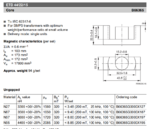ivan_mateo
Member level 1
Hi everyone,
I am planning to design a full bridge converter and it should be close to %92-93 efficiency. First of all, I need to overcome my transformer design problem.
In my calculation, the output voltage and current is 30V,40A and the output power is 1200W. The input power is around 1300W based on that efficency. The minimum input 170VAC, peak is 239,7V, Vavg is 152,6V.
I have chosen that ETD/44/22/15(Ve=17800mm^3,Ae=173mm^2) and N97 core which has 100mT at 100kHz,25'C. And 135.28kW/m^3 at 100mT. Pcore losses=2.4W. When I calculated my Nprimary turn using that formula V=4xNx2BxAexfs, Nprimary is equal 22T.
But in there my confusion is how to calculate my input current and from that Lprimary inductance. I have some knowledge about it that the inductane is proportional to the square of primary turns. And there is AL factor. L= ALxN^2
But also AL =1/Reluctance of core. And As I shown below document from TDK, there is AL value for N97 core and there is some info related to calculate Reluctance Me and le . But Al equal 1/Reluctance but when I calcuate it, it is not equal to AL calue for N97.
Can anybody help solve this step?
I am planning to design a full bridge converter and it should be close to %92-93 efficiency. First of all, I need to overcome my transformer design problem.
In my calculation, the output voltage and current is 30V,40A and the output power is 1200W. The input power is around 1300W based on that efficency. The minimum input 170VAC, peak is 239,7V, Vavg is 152,6V.
I have chosen that ETD/44/22/15(Ve=17800mm^3,Ae=173mm^2) and N97 core which has 100mT at 100kHz,25'C. And 135.28kW/m^3 at 100mT. Pcore losses=2.4W. When I calculated my Nprimary turn using that formula V=4xNx2BxAexfs, Nprimary is equal 22T.
But in there my confusion is how to calculate my input current and from that Lprimary inductance. I have some knowledge about it that the inductane is proportional to the square of primary turns. And there is AL factor. L= ALxN^2
But also AL =1/Reluctance of core. And As I shown below document from TDK, there is AL value for N97 core and there is some info related to calculate Reluctance Me and le . But Al equal 1/Reluctance but when I calcuate it, it is not equal to AL calue for N97.
Can anybody help solve this step?

